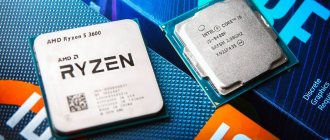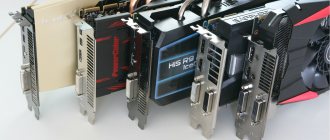When planning an upgrade or purchase of a personal computer, many gamers are interested in the question, which video card is best for gaming? Almost all modern video games delight not only with dynamic, spectacular gameplay and high-quality graphics, but are also very demanding on system resources. Therefore, in order to get maximum pleasure from the gameplay, to fully experience the visual beauty, and not to be nervous about freezes and glitches in the game, you need a fairly powerful computer with a good gaming video card installed. Even if processors have integrated graphics, this is not enough for new games. You'll have to play on minimum or medium settings. What do you need to know when choosing a gaming video card?
NVIDIA GEFORCE GTX 1660TI
GPU – TU116 | CUDA Cores – 1,536 | Memory – 6GB GDDR6 | Bus – 192-bit
pros:
- GTX 1070 level framerate
- GTX 1060 level price
- All the delights of Turing architecture
Nvidia's consumer graphics card takes advantage of all the shader benefits of the Turing 20xx series architecture, but lacks the ray tracing and intelligent processing that set the RTX line apart from other GPUs. However, given the small number of games that effectively use ray tracing, this loss is not so significant. And it becomes even smaller if you remember at what cost to PC performance all this beauty comes.
The GTX 1660 Ti took first place due to the fact that it has just enough power to justify the cost difference with the RX 580. Overclocked cards like the STRIX GTX 1660 Ti are too expensive, closer to the RTX 2060 and RX 5700, but at the RRP The GTX 1660 Ti has no rivals.
NVIDIA GEFORCE GTX 1660
GPU – TU116 | CUDA Cores – 1,408 | Memory – 6GB GDDR5 | Bus – 192-bit
pros:
- Still better than Polaris
- Turing architecture
Minuses:
- Not so "new"
- Polaris wins on cost
Since new Polaris GPUs appeared on the market in the sub-$300 segment, the position of the GTX 1660 has seriously weakened. The Nvidia card still has a slight performance advantage, which gives it the lead, making up for the difference in cost. Not yet.
When we spend money, we expect to get the highest possible framerate for it, and green GPUs still meet our needs. In addition, they are equipped with new technologies Integer Scaling (scaling without blur) and Low Latency Mode (low latency mode), which AMD video cards lack.
NVIDIA GEFORCE RTX 2070 SUPER
GPU – TU104 | CUDA Cores – 2,560 | Memory – 8GB GDDR6 | Bus – 256-bit
pros:
- Performance equal to GTX 1080 Ti
- Adequate price tag
- Ray tracing
Minuses:
- Awkward proximity to the RX 5700 XT
The RTX 2070 Super was born to win with the new Navi chips. Since AMD took aim at the old RTX 2070, Nvidia released its updated version - cheaper and slightly inferior to the 2080.
She's fast. Really fast. You can squeeze impressive results out of this card, far surpassing the best result of Pascal on the GTX 1080 Ti. And considering the fact that the 2070 costs a couple hundred dollars less than the 2080, you can imagine how good of an offer this is.
AMD RADEON RX 5700 XT
GPU – Navi 10 | RDNA Cores – 2,560 | Memory – 8GB GDDR6 | Bus – 256-bit
pros:
- Slightly inferior to RTX 2070 Super
- Cheaper than RTX 2070 Super
- Beats RTX 2060
Minuses:
- The reference card is noisy and gets hot
Thanks to aggressive pricing, AMD has created a real monster that can not only make the RTX 2070 Super tense, but also allow you to save money. Yes, the Nvidia card is more powerful, but the difference is incredibly small.
The best part about this is that for the money, the RT 5700 XT almost takes us to the promised land of high-end GPUs, challenging the green gang. If only it (in its reference form) wasn’t so noisy and burning.
AMD RADEON RX 5700
GPU – Navi 10 | RDNA Cores – 2,304 | Memory – 8GB GDDR6 | Bus – 256-bit
pros:
- Same chip as XT version
- Much like the RTX 2060 Super
Minuses:
- Noisy and gets hot
Immediately after its XT companion comes the RX 5700, running on the same chip, but with reduced frequencies. By the way, this also affects acceleration: even in capable hands, it will still be inferior to its older sister.
And this is sad, because the RX 5700 is an excellent, powerful video card with a moderate price and performance that can put Nvidia to shame in its price segment.
How to choose the right gaming video card for your motherboard?
First, let's look at the types of video cards. Now there are the following main types:
- Built-in , called integrated . They are embedded directly into the motherboard or processor chipset.
- Discrete , connecting to special connectors or slots on the motherboard.
We recommend the second type of video card models. They are divided into: gaming, multimedia and professional.
- Gaming ones are the most powerful of the options, which require a fairly high-power processor and motherboard.
- Multimedia devices are designed for watching FULL HD videos and films, running regular gaming applications and, in general, for work activities on a PC.
- Professional- video cards are the most expensive of all. Let’s say “Nvidia PNY K80” costs 302,000 rubles. Such maps are mainly suitable for specialists in the field of 3D modeling. Do you have a fairly basic PC, such as a Pentium or Celeron processor? Then choose a video card with low performance, since for a weak computer it is undesirable to purchase a powerful video card due to possible problems due to the dissimilarity of the components.
NVIDIA GEFORCE RTX 2080TI
GPU – TU102 | CUDA Cores – 4,352 | Memory – 11GB GDDR6 | Bus – 352-bit
pros:
- Serious Gaming – 4K/60fps
- Faster than the $3,000 Titan V
- All the delights of ray tracing and AI
Minuses:
- Conservative price tag
Here it is, the true nextgen. GPU based on Turing architecture, an ultra-modern and unsurpassed “king of graphics”, easily taking the title of the best video card. While the RTX 2080 and 2070 Super are capable of GTX 1080 Ti-level performance, this card leaves them in the dust, giving you 4K/60fps in all but the most demanding of modern games.
No matter how you feel about the new-fangled (for PC gaming) ray tracing technology, there's no escaping it in the future, and the RTX 2080 Ti is ready for it. With the release of PS5 and Xbox Series X consoles that support ray tracing, there will be more and more games with corresponding graphical effects, and sooner or later you will have to upgrade.
Video card manufacturers
A video card (video adapter) can be called the heart of any PC or laptop. They are responsible for the construction and quality of images displayed on the screen. If a video adapter is not installed on your computer, modern games simply will not work without a video card. In this case, you can only play primitive flash games or toys from 10 years ago. On the modern computer market there is a fairly large selection of video cards that have a wide variety of technical specifications. operational characteristics and parameters.
The most popular video card manufacturers that have held their positions for several years include:
- Asus,
- Zotac
- InnoVision (Inno3D),
- MSI,
- Palit,
- PNY
- PowerColor
- Gigabyte
- Sapphire.
Before being sent for sale, products are tested and undergo strict control. Therefore, in the first year of active use, users, as a rule, do not experience problems. MSI, Asus, Gigabyte have especially low failure rates.
The reliability of a video card is difficult to track in the first two to three years. As a rule, problems begin when the card's heatsink becomes covered with a thick layer of dust, the characteristics of the thermal paste between the heatsink and the chip deteriorate, and the cooling system fails. Wear and tear of hardware elements, technical malfunctions, and overheating can also significantly reduce the service life of a video card and cause incorrect and unstable operation.
NVIDIA GEFORCE RTX 2080 SUPER
GPU – TU104 | CUDA Cores – 2,944 | Memory – 8GB GDDR6 | Bus – 256-bit
pros:
- Great gaming in 4K
- RTX Turing architecture
Minuses:
- Not far behind the RTX 2070 Super
The days of the RTX 2080 were numbered as soon as Nvidia admitted that it would soon release a Super version.
The new video card turned out to be more powerful than the GTX 1080 Ti thanks to more cores and faster memory. The only problem is that its younger sister, the RTX 2070 Super, is almost as good in price and power, so sometimes you might wonder why the RTX 2080 Super is needed?
And yet, the latter has the best performance with best traceability at the sub-$1000 mark.
AMD RADEON RX 5600 XT
GPU – Navi 10 XLE | RDNA Cores – 2,304 | Memory – 6GB GDDR6 | Bus – 256-bit
pros:
- Better than RTX 2060 in DX12
- Smart PCB design
- Good performance at 1080p and 1440p
The AMD Radeon RX 5600 XT video card performs well at 1080p and slightly worse at 1440p, and will show modest results at 4K resolution. Its main advantage is the new RDNA architecture on a 7-nm process technology, due to which gamers can expect impressive results in DX12 applications, where the video card confidently outperforms its competitor from the “green” camp – NVIDIA GeForce RTX 2060.
However, you might be thinking that it would be nice to add a little and get the more powerful RX 5700 XT. Well, we won't judge you for that.
TOP 5 video cards for premium games
Flagship models will allow you to play at ultra settings without dropping FPS over the next few years.
ASUS TUF Gaming GeForce RTX 3070 OC 8GB (TUF-RTX3070-O8G-GAMING), Retail
The premium model B, which supports DirectX 12 Ultimate and OpenGL 4.6 gaming technologies, will delight owners of powerful gaming computer systems with unprecedented performance.
The performance of this model is ensured by the latest generation video chip and eight gigabytes of its own GDDR6 memory.
Correct operation of the ASUS TUF Gaming GeForce RTX 3070 OC 8G device will be ensured by a power supply of at least 750 watts.
Additional food will also be required. HDMI and DisplayPort connectors allow you to connect one or more monitors.
Their total maximum resolution can be 7680x4320 pixels.
A three-fan cooling system with a powerful radiator and heat pipes ensures heat removal from key board elements.
Specifications:
- GPU - GeForce RTX 3070;
- interface - PCI-E 16x 4.0;
- video resolution - 7680x4320;
- base GPU frequency - 1.8 GHz;
- video memory - 8 Gbyte, GDDR6;
- ports - HDMI, DisplayPort;
- additional power supply - 8+8 pin;
- recommended power supply unit - 750 W;
- cooling - 3 fans;
- Dimensions – 300×127×52 mm (3 slots).
Advantages
- metal body elements;
- impressive power and speed;
- there is potential for overclocking;
- Quiet and efficient cooling.
Flaws
- inflated price tag;
- impressive weight;
- high nutritional requirements.
MSI GeForce RTX 3090 GAMING X TRIO 24GB, Retail
The MSI GeForce RTX 3090 GAMING X TRIO 24GB platform stands out from its analogues due to its long service life without breakdowns, modern design and the use of innovative assembly technologies.
High-quality materials and professional assembly ensure maximum quality and performance in gaming projects.
In technical terms, the model boasts a powerful graphics processor and its own video memory of 24 Gbyte.
Gaming software components - OpenGL 4.6 and DirectX 12 provide compatibility and unique effects in modern games.
The cooling system consists of three fans and a powerful radiator.
To ensure maximum performance when running games, you will need a power supply of 750 watts or higher.
Specifications:
- GPU - GeForce RTX 3090;
- interface - PCI-E 16x 4.0;
- video resolution - 7680x4320;
- base GPU frequency - 1.8 GHz;
- video memory - 24 Gbyte, GDDR6X;
- ports - HDMI, DisplayPort;
- additional power supply - 8+8+8-pin;
- recommended power supply unit - 750 W;
- cooling - 3 fans;
- Dimensions: 323×140×56 mm (3 slots).
Advantages
- high quality components and assembly;
- efficient cooling system;
- stability of work;
- stylish design.
Flaws
- low overclocking potential;
- large overall dimensions;
- premium price tag.
MSI GeForce RTX 3070 Gaming X Trio 8GB, Retail
Graphics Unit B is the latest iteration of MSI's iconic Gaming series, combining super-fast speed, high-performance cooling and a unique design.
The MSI GeForce RTX 3070 Gaming X Trio 8G device is equipped with synchronized backlighting, which has the option to completely turn off.
The updated active-passive cooling features dual-blade Torx fans, heat pipes and a radiator.
The node provides maximum contact area with the graphics chip; it evenly distributes heat over the surface and removes excess heat.
The card stands out for its original engineering solutions and well-thought-out technologies; the manufacturer guarantees a long service life of the device even with intensive use.
Specifications:
- GPU - GeForce RTX 3070;
- interface - PCI-E 16x 4.0;
- video resolution - 7680x4320;
- base GPU frequency - 1.8 GHz;
- video memory - 8 Gbyte, GDDR6;
- ports - HDMI, DisplayPort;
- additional power supply - 8+8 pin;
- recommended power supply unit - 650 W;
- cooling - 3 fans;
- Dimensions: 323×140×56 mm (3 slots).
Advantages
- efficient cooling;
- excellent performance;
- comfortable fan noise level;
- Convenient settings and controls, user-friendly software.
Flaws
- ugly lighting;
- impressive dimensions;
- expensive model.
MSI GeForce RTX 3070 Ventus 3X OC 8GB
The gaming model B, based on a graphics chip with Ampere microarchitecture, will delight users with unprecedented performance and provide the opportunity to turn a PC into an advanced gaming device.
The MSI GeForce RTX 3070 Ventus 3X OC 8G equipment uses modern computing units and super-fast GDDR6 video memory.
The card is focused on maximum performance; its design is laconic and does not contain anything superfluous.
A three-fan cooler is responsible for cooling in this model.
The overall design is complemented by a graphene backplate that performs multiple tasks simultaneously, including protection and passive cooling.
The video card is also equipped with a reinforced power bus.
Specifications:
- GPU - GeForce RTX 3070;
- interface - PCI-E 16x 4.0;
- video resolution - 7680x4320;
- base GPU frequency - 1.7 GHz;
- video memory - 8 Gbyte, GDDR6;
- ports - HDMI, DisplayPort;
- additional power supply - 8+8 pin;
- recommended power supply unit - 650 W;
- cooling - 3 fans;
- Dimensions: 305×121×52 mm (3 slots).
Advantages
- high quality of materials and workmanship;
- relatively quiet cooling system;
- the presence of special protective stiffeners;
- latest generation graphics processor.
Flaws
- poor equipment;
- large dimensions and weight;
- only one HDMI connector.
MSI GeForce RTX 3080 Gaming X Trio 10GB
A representative of the iconic Gaming line, the cardB with ten gigabytes of its own memory combines not only advanced technical characteristics, but also impeccable aesthetics for true fans.
The MSI GeForce RTX 3080 Gaming X Trio 10G ensures that you can run modern games without losing performance or reducing FPS.
At the same time, overheating of the equipment is eliminated thanks to a highly efficient cooling system with minimal noise levels even under heavy loads.
The built-in backlight, which can be turned off if desired, can synchronize with other system components.
The platform is equipped with a number of other interesting engineering solutions.
Specifications:
- GPU - GeForce RTX 3080;
- interface - PCI-E 16x 4.0;
- video resolution - 7680x4320;
- base GPU frequency - 1.8 GHz;
- video memory - 10 Gbyte, GDDR6X;
- ports - HDMI, DisplayPort;
- additional power supply - 8+8+8-pin;
- recommended power supply unit - 750 W;
- cooling - 3 fans;
- Dimensions: 323×140×56 mm (3 slots).
Advantages
- silent cooling system;
- laconic, strict design;
- high performance;
- good compatibility.
Flaws
- plastic backplate;
- heating under load.
NVIDIA GeForce RTX 2060 SUPER
GPU – TU106 | CUDA Cores – 2,176 | Memory – 8GB GDDR6 | Bus – 256-bit
pros:
- Accelerates well
- Supports RTX and DLSS 2.0
- 8 GB video memory
Minuses:
- Not cheap
An RTX 2060 is the minimum required graphics card to enter the magical world of ray tracing (even though the technology is still imperfect, games with RTX are truly transformed). What's even more important: thanks to DLSS 2.0, this video card allows you to play at 1440p resolution without losing FPS and with maximum graphics settings.
If you choose between RTX 2060 and RTX 2060 SUPER, then we would recommend the second one: it has better overclocking potential, more memory and higher frequencies, which means it will remain relevant longer in comparison with the younger version.
Video memory capacity
Many users believe that the larger the local volume of the video adapter, the higher its performance and power. As a rule, this parameter can vary from 512 MB to 11 GB. But contrary to popular belief, the performance of video adapters depends on the video chip, and video memory only stores data about it. Of course, if the model has a small amount of memory, the card simply will not be able to reveal its full potential.
To run games in Full HD resolution and play comfortably at maximum quality settings, no more than 4 GB of video memory is sufficient. Moreover, if the video memory capacity is 2 GB, this parameter has virtually no effect on the frame rate or reduces them slightly.
Often budget video cards have a fairly large amount of memory. But this is just a successful marketing ploy to increase sales. Note that a large volume for weak video cards is simply useless, since they have a weak video chip that is not capable of delivering the required frame rate when playing at high, maximum and even medium settings.
Note that 1-2 GB is enough for inexpensive budget card models, 2-4 GB for mid-level video cards, and the most powerful gaming video adapters should have at least 4 GB.
NVIDIA GeForce GTX 1050 Ti
GPU – GP107 | CUDA Cores – 768 | Memory – 4GB GDDR5 | Bus – 128-bit
pros:
- Inexpensive
- Runs all modern games
Minuses:
- Will soon become irrelevant
If the RTX 2060 is the minimum threshold for entering games with ray tracing, then the GTX 1050 Ti is the minimum required video card for games in principle. Of course, you will have to make compromises with it: it is suitable for gaming at a resolution no higher than 1080p, and it is better to forget about maximum graphics settings.
On the other hand, it is very cheap (although it could be even cheaper) and will run all modern video games - even from the AAA segment. However, it should be noted that with the release of a new generation of consoles, its performance will no longer be enough.
How to choose a gaming video card?
Computers no longer surprise anyone in the modern world. But every user of such equipment knows that the most expensive thing, without which the computer simply does not work, is a video card. To make the right choice of such equipment, you need to study all the offers.
All advanced users are well aware that there are several types of video cards. For example, they can be built into either the motherboard itself, or it can be inserted into the processor. Integrated video cards are rare, but they are still more suitable for a laptop. And those video cards that are already inserted directly into the motherboard are selected more carefully. But such discrete video cards, which are located on the motherboard, allow you to watch movies of the highest quality and play games that have high graphics images.
When buying a computer, it is better to pay special attention to the choice of video card. It is necessary to know exactly its parameters and characteristics. The graphics chip is the most important element responsible for the processor graphics frequency. When purchasing we advise:
- Consider the amount of memory on the video card. It is known that memory is responsible for those images that are created on the device and only then stored. Therefore, memory differs in frequency and type, bus width and volume. Taking into account the knowledge about these components of the video card, select it so that it fits perfectly with the computer.
- Decide for what purpose you want to purchase it. For modern games, you will need the most powerful graphics card.
- Pay attention to resolution . The higher the resolution, the higher the card class required.
AMD RADEON RX 570
GPU – Polaris 20 | GCN Cores – 2,048 | Memory – 4GB GDDR5 | Bus – 256-bit
pros:
- Great price
- Serious power for 1080p
- Tire wider than 1050 Ti
Minuses:
- Only slightly inferior to the RX 580
An excellent budget video card that can make the GTX 1050 Ti shine with its presence. There is an 8GB version of the RX 570 on the market, however, the premium for the extra 4 gigabytes brings it very close to the cost of the RX 580, which now, admittedly, looks very attractive.
Still, the 4GB RX 570 is capable of handling the highest settings at 1080p. A true budget hero.
Cooling system
Powerful video card models have increased heat dissipation and heat up during operation, especially when a resource-intensive game is running. Severe overheating significantly reduces the card's lifespan and can cause the card to fail. Artifacts may appear in games when overheated. Therefore, you need to make sure that in addition to the radiator there are good fans (cooler).
Cooling can be custom or reference. Reference cooling is installed on AMD and NVidia GPUs, custom cooling is installed on Asus, Gigabyte, PowerColor and other manufacturers. Higher efficiency with low noise is ensured by custom cooling. When using reference cooling, video card chips operate at low settings in order to reduce heat transfer. Used video chips that have not passed the test during testing in normal operating mode can be used. Therefore, their reliability will be significantly lower than that of models with active cooling.
AMD RADEON RX 580 8GB
GPU – Polaris 20 | GCN Cores – 2,304 | Memory – 8GB GDDR5 | Bus – 256-bit
pros:
- Excellent card for 1080p
- 8GB memory
- Great price tag
The price of the RX 580 has decreased, and it has found itself in the budget segment. Its price tag may not be attractive enough for many, but the video card is worth every penny invested in it. After all, just a couple of years ago it was AMD's flagship. In fact, it is still capable of producing impressive results in 1080p and even 1440p.











